Last updated on October 9th, 2022
Bolivia, officially the Plurinational State of Bolivia, is a landlocked country located in western-central South America. It has a total area of 1,098,581 square km. Sucre is its constitutional capital while La Paz is its seat of government. Spanish is one of its official languages. Its official currency is Boliviano (BOB). Bolivia is bordered by Argentina, Chile, Peru, Brazil and Paraguay. One-third of the country is within the Andean mountain range. With these interesting facts about Bolivia, let’s learn about its culture, history, economy, people, industries, tourism, tradition, religion and more.
Facts about Bolivia
1. Bolivia and Paraguay are the only two landlocked South American countries. Bolivia is the highest and most isolated country in South America.[35]
2. Bolivia changed its official name from “Republic of Bolivia” to “Plurinational State of Bolivia” in 2009.
3. This fact about Bolivia is for the history buffs. Bolivia was known as Upper Peru during the Spanish rule.
4. Spanish is the native tongue of more than 40% of the country’s population. Quechua and Aymara are among the official languages of Bolivia. In rural areas, indigenous people speak their own languages.[30]
Bolivia on the map
5. Indigenous people make up about two-thirds of its population.
6. Did you know that the former president of Bolivia, Evo Morales, was the first member of the indigenous majority to be elected as the president of Bolivia? He stayed in the position of power after his election in December, 2005 until November 10, 2019.[24]
7. Military service is obligatory in Bolivia for all men between the ages of 18 and 22.[38]
The state flag of Bolivia

Facts about famous tourist attractions in Bolivia
8. One of the world’s largest butterfly sanctuaries, which spans 24 hectares, is in Bolivia. It is located 20 minutes from downtown Santa Cruz and is open 365 days a year.[31]
9. A variety of amenities are available inside the sanctuary for the visiting guests. There are restaurants, bars, tent-camping facilities, bungalows, a resort hotel, picnic, and barbeque areas, a huge are’s playground, biolabs and much more. You can spend weeks — not just days — inside the sanctuary without running out of things to see.
10. The North Yungas Road, which is also known as the Road of Fate or Death Road, is in Bolivia. It is 56 kilometers long, and as per an estimate, nearly 200-300 people died from falling off the road every year until recently when improvements were made to the road to avoid casualties. The road also has cross markings on the places where vehicles have fallen in the past to alert the passing drivers.
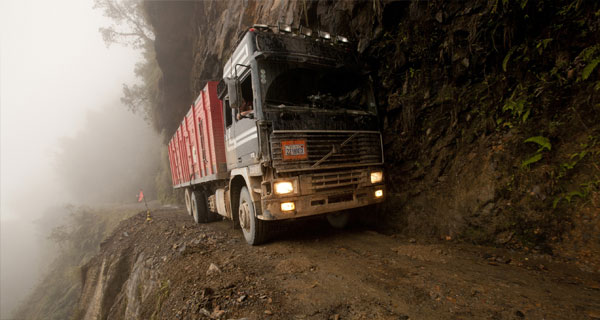
11. On the list of interesting Bolivia facts, this certainly deserves mention. Bolivia has the world’s largest salt flat (the Salar de Uyuni), which covers 10,582 square kilometers (4,086 sq mi) of the area and is 3,656 meters above sea level. It is almost 100 times larger than the famous Bonneville Salt Flats in Utah, USA. It contains 50 to 70% of the world’s lithium reserves.[12] Note that the altimeters of Earth observation satellites are calibrated on the salt desert due to its large area, clear skies, and exceptional flatness. It is one of the most famous tourist attractions in Bolivia.[1]
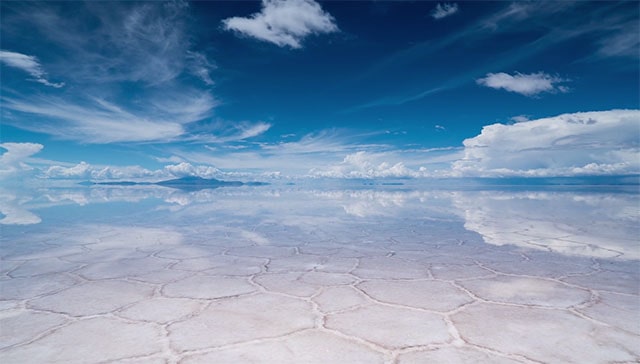
12. Madidi National Park, with an area of 18,958 square kilometers, is part of one of the largest protected areas in the world. Researchers have documented at least 8,500 species so far and estimate that the total could be around 11,400. Species counts are never definitive, however.[34]
13. Tiwanaku, located in Bolivia, is among South America’s most intriguing archeological sites.[14]
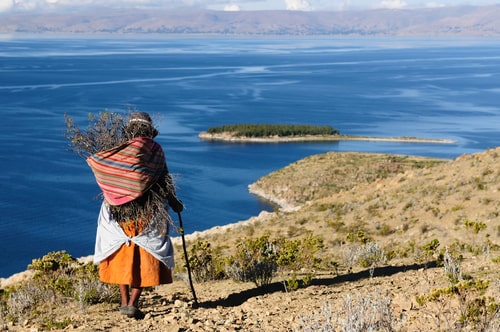
14. Bolivia also has Lake Titicaca, which is the world’s highest navigable lake at 12,507 (3810 m) feet above sea level. It has a surface area of 8,300 square kilometers. It is shared between Bolivia and Peru.[15]
15. San Pedro prison in Bolivia is another tourist attraction. Unlike other prisons around the world, this special prison permits its inmates to live with their families, work, earn and even buy or rent their accommodations.[16]
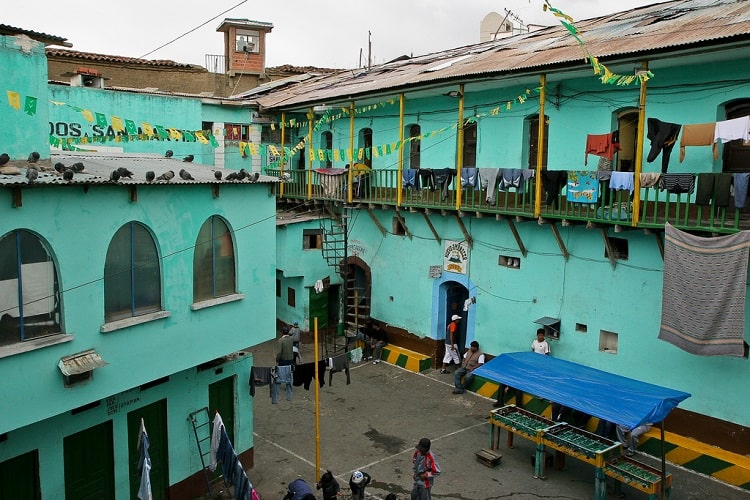
16. Another interesting fact about Bolivia is that a hotel in Bolivia–the Hotel Luna Salad–is built entirely from salt blocks including the interior and the furniture.[17]

17. For those who have a special interest in dinosaurs, it will be interesting to know that there are 5055 footprints from at least 8 different species of dinosaurs in Bolivia on Cal Orko, an imposing limestone slab 1.5 km long and approximately 80 meters high. The marks are 68 million years old. And they are on a vertical wall.[18]
Amazed? Want to know how was it possible for the dinosaurs to walk on a vertical wall? Learn that tectonic plate activity pushed the flat ground at such an incredible angle that it became a famous tourist spot for visitors from all over the world.
18. The Dolphins (Bolivian Bufeo) in the Amazon in Bolivia are pink. It has been declared Bolivia’s Natural Heritage.[26,27]
19. The guinea pig is a delicacy in Bolivia. It is usually served whole, with the legs and head pointing up.[28]

20. The llama, the largest animal on the Altiplano, is a source of meat, wool, leather, tallow, and fuel (in the form of dried dung) in rural Andean communities.[37]
Facts about Bolivia’s history
21. During the 18th century, Bolivia was known as Upper Peru. It got its name from Simon Bolivar, the military and political leader.[19]
22. Bolivia became independent on August 6, 1825 (from Spain).
23. An estimated eight million Andean Indians died because of the mining of Cerro Rico (Rich Hill). The highest point of the mine lies at an elevation of 4,782 meters. Each day, approximately 3,000 tons of minerals are brought out of it by around 15,000 miners.[20,21,22]
24. Slavery was abolished in Bolivia in 1831.
List of the countries with multiple capital cities
| Name of country | Name of its capitals |
|---|---|
| Benin | Cotonou and Porto-Novo |
| Bolivia | La Paz and Sucre |
| Chile | Santiago and Valparaiso |
| Georgia | Kutaisi and Tbilisi |
| Honduras | Comayaguela and Tegucigalpa |
| Ivory Coast | Abidjan and Yamoussoukro |
| Malaysia | Kuala Lumpur and Putrajaya |
| Montenegro | Cetinje and Podgorica |
| Netherlands | Amsterdam and The Hague |
| South Africa | Bloemfontein, Cape Town, and Pretoria |
| South Korea | Sejong City and Seoul |
| Sri Lanka | Colombo and Kotte |
| Swaziland | Lobamba and Mbabane |
| Tanzania | Dar es Salaam and Dodoma |
| Western Sahara (Sahrawi Arab Democratic Republic | Laayoune and Tifariti |
25. Interestingly, there are 37 official languages (Spanish and 36 indigenous languages) in Bolivia.[24]
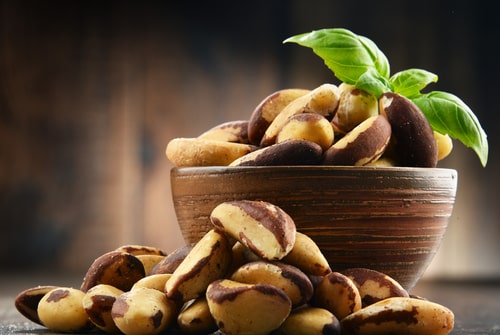
26. Bolivia contributes 70% of all Brazil nuts produced worldwide. According to a source, nearly 25 million tonnes are exported mainly to Brazil, the United States and Europe every year.[25]
About Bolivia’s geography
27. Bolivia is home to the highest administrative capital city in the world, La Paz. It is roughly 11,975 ft above sea level. It has one airport and has a population of 1.816 million. However, the official capital city of Bolivia is Sucre. Thus, it is one of the few countries in the world with more than one capital cities. When Bolivians refer to the capital, they are talking about La Paz.[23,30]

28. After Brazil (8,515,770 sq km), Argentina (2,780,400 sq km), Peru (1,285,216 sq km) and Colombia (1,138,910 sq km); Bolivia (1,098,581 sq km) is the fifth largest country in South America, and the 27th largest in the world.
29. Bolivia is almost three times the size of Montana (one of the 50 U.S. states.)
30. Only about 11% of all roads in Bolivia are paved.[27]
31. Sadly, Bolivia’s second-largest lake, Lake Poopo, has dried up due to climate change. The Lake is situated more than 12,000 feet above sea level on the country’s Andean plains.
32. Bolivia extends some 950 miles (1,500 km) north-south and 800 miles (1,300 km) east-west.[37]
33. Bolivia’s mountainous western region is one of the highest inhabited areas in the world.[37]
Famous people from Bolivia
34. Soccer is the main sport in Bolivia. It is also its national sport.[30]
Below are some famous people from Bolivia from various categories and fields of work.
Sports: Maria Fernanda Álvarez (tennis), Geovana Irusta (running), Bernardo Guarachi (mountain climbing), Paulo Víctor Aguilera (BMX racing), Marco Antonio Etcheverry (soccer), Mariel Diamond and Carola Nostas (bodybuilding) are some famous athletes from Bolivia.
Acting: Reynaldo Pacheco, Raquel Welch, Jorge Ortiz, Arturo Lora, David Mondacca, David Santalla, Eduardo Hoffmann, Milton Córtez, Carla Ortiz, Peter Travesí and Marcos Malavia are some famous actors from Bolivia.
Science: Noel Kempff Mercado, José Steinbach, Martín Cárdenas and Iván Guzmán de Rojas are some famous scientists from Bolivia.
Literature: Edmundo Paz Soldán, Eduardo Scott-Moreno, Giovanna Rivero, Adolfo Costa du Rels, Antonio Díaz Villamil, Adela Zamudio, Ricardo Jaimes Freyre, Maria Josefa Mujia, Alcides Arguedas, Javier del Granado, Nataniel Aguirre, Tomás O’Connor d’Arlach, Yolanda Bedregal, Jaime Saenz and Juan de Recacoechea are some of the prolific writers from Bolivia.
About Bolivia’s economy
35. Bolivia is the 95th-largest export economy in the world (est. 2017). Natural gas, silver, zinc, lead, tin, gold, quinoa, soybeans and soy products are among Bolivia’s top exports. It imports machinery, petroleum products, vehicles, iron and steel, plastics. Bolivia has the second-largest reserves of natural gas in South America. However, Russia holds about one fourth of the world’s total proven gas reserves. Russia, Iran, Qatar, the United States of America, and Saudi Arabia are the other countries with the largest natural gas reserves in the world, respectively.[32,35,36]
36. As per the World Bank’s report, nearly 1,239,000 tourists visited Bolivia in 2019.
37. Almost half of the labor force in Bolivia is engaged in agriculture.
38. After Venezuela, Bolivia is the second poorest country in South America.
39. Schooling is free and compulsory for children between the age of 5 and 18.
Interesting facts about Bolivian customs and tradition
40. There are 36 indigenous cultures (at the time of this writing, they constitute between 62 to 70 percent of the country’s population) in Bolivia. Each has its own customs and languages. The Quechua are the largest culture of Bolivia, while the Aymara are the second largest in the region.[29]
41. Bolivians admire honesty. Kindness, gentleness, and concern for another’s welfare are keys to friendship in Bolivia.[30]
. . . continue reading on the next page
